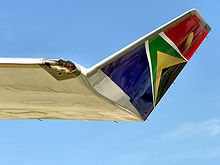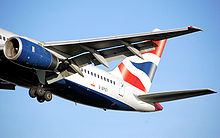- Navigation light
-
 The winglet and red navigation light on the port (left) wing of a South African Airways Boeing 747-400 aircraft
The winglet and red navigation light on the port (left) wing of a South African Airways Boeing 747-400 aircraft
A navigation light is a colored source of illumination on an aircraft, spacecraft, or waterborne vessel, used to signal a craft's position, heading, and status. Commonly, their placement is mandated by international conventions or civil authorities.
Navigation lighting systems include:
- Right-of-way lights - On ships, aircraft and piloted spacecraft, a red light will be mounted on the left or port side of the craft and a green on the right or starboard side. These help two craft on a collision course determine who has right-of-way. When two vessels have crossing paths, each will see a red or green running light. The one on the port side of the other, which must yield right of way, will see red, while the one on the starboard side of the other, which has right of way, will see green.
 A British Airways Boeing 757-200 lands. The port wing tip carries a red navigation light.
A British Airways Boeing 757-200 lands. The port wing tip carries a red navigation light.
- Strobe lights - On aircraft primarily, strobe lights flash a high-intensity burst of white light, to help other pilots recognize the aircraft's position in low-visibility conditions.
Contents
In 1838 the United States passed an act requiring steamboats running between sunset and sunrise to carry one or more signal lights; color, visibility and location were not specified. In 1848 the United Kingdom passed regulations that required steam vessels to display red and green sidelights as well as a white masthead light. In 1849 the U.S. Congress extended the light requirements to sailing vessels. In 1889 the United States convened the first International Maritime Conference to consider regulations for preventing collisions. The resulting Washington Conference Rules were adopted by the U.S in 1890 and became effective internationally in 1897. Within these rules was the requirement for steamships to carry a second mast head light. The international 1948 Safety of Life at Sea Conference recommended a mandatory second masthead light solely for power driven vessels over 150 feet in length and a fixed sternlight for almost all vessels. The regulations have changed little since then. [1]
The International Regulations for Preventing Collisions at Sea established in 1972 stipulates the requirements for the navigation lights required on a vessel.Basic lighting
To avoid collisions, vessels mount navigation lights that permit other vessels to determine the type and relative angle of a vessel, and thus decide if there is a danger of collision. In general sailing vessels are required to carry a green light that shines from dead ahead to 2 points (22½°) abaft the beam on the starboard side, a red light from dead ahead to two points abaft the beam on the port side and a white light that shines from astern to two points abaft the beam on both sides. Power driven vessels, in addition to these lights, must carry either one or two (depending on length) white masthead lights that shine from ahead to two points abaft the beam on both sides. If two masthead lights are carried then the after one must be higher than the forward one.[2] Some boats operating in crowded areas may also carry a yellow flashing beacon for added visibility during day or night.
Lights of special significance
In addition to red, white and green running lights, a combination of red, white and green Mast Lights placed on a mast higher than all the running lights, and viewable from all directions, may be used to indicate the type of craft or the service it is performing. See "Quick Guide" in external links.
- Ships at anchor display one or two white anchor lights (depending on the vessel's length) that can be seen from all directions. If two lights are shown then the forward light is higher than the aft one.
- Boats classed as "small" are not compelled to carry navigation lights and may make use of a handheld torch.
Aircraft navigation lights are placed in a way similar to that of marine vessels, with a red navigation light located on the left wingtip leading edge and a green light on the right wingtip leading edge. A white navigation light is as far aft as possible on the tail or each wing tip.[3] High-intensity strobe lights are located on the aircraft to aid in collision avoidance.[4]
Navigation lights in civil aviation are required to be turned on from sunset to sunrise. High-intensity white strobe lights are part of the anti-collision light system, as well as the aviation red or white rotating beacon. The anti collision light system (either strobe lights or rotating beacon) is required for all airplanes built after March 11, 1996 for all flight activities in poor visibility, and recommended in good visibility, where only strobes and beacon are required. An example of this would be just before push back, (push and start) the beacon lights are required, to notify ground crews that the engines are about to be started. These beacon lights will stay on for the duration of the flight. While taxiing, the taxi lights are activated. When coming onto the runway, the taxi lights are deactivated and the landing lights and strobes are activated. When passing 10000 feet (or FL100) the landing lights are no longer required, and can be turned off at the pilot's discretion. The same cycle works when landing, but in reverse order. There are also other non-navigational lights on civilian commercial airliners. These include the logo lights which illuminate the company logo on the tail fin of the aircraft. These lights are optional to be turned on, however though most pilots switch them on at night for noticeable visibility from other aircraft. Modern airliners also have a wing light. These are positioned on the outer side just in front of the engine cowlings on the fuselage. These are not required to be turned on, but in some cases pilots turn these lights on for engine checks and also while passengers board the aircraft for better visibility of the ground near the aircraft.
References
- ^ Handbook of the Nautical Rules of the Road Llana and Wisneskey
- ^ The International Regulations for the Prevention of Collisions at Sea, Part C, Lights and Shapes
- ^ "Federal Aviation Regulation, Part 23 Airworthiness Standards: Normal, Utility, Acrobatic and Commuter Category Airplanes, Subpart F: Equipment--Lights, Section 23.1385 Position Light System Installation". http://www.airweb.faa.gov/Regulatory_and_Guidance_Library/rgFAR.nsf/0/1F344D1F7DF924C7852566870072238A. Retrieved 2006-12-01.
- ^ "Federal Aviation Regulation, Part 23 Airworthiness Standards: Normal, Utility, Acrobatic and Commuter Category Airplanes, Subpart F: Equipment--Lights, Section 23.1401 Anticolllision Light System". http://www.airweb.faa.gov/Regulatory_and_Guidance_Library/rgFAR.nsf/0/460D019A348B98DF8525668700728C0B. Retrieved 2006-12-01.
External links
- Mnemonics for light pattern recognition
- Photo-History 19th and 20th Century Oil Burning Shipboard Navigation Lights
Lists relating to aviation General Aircraft (manufacturers) · Aircraft engines (manufacturers) · Airlines (defunct) · Airports · Civil authorities · Museums · Registration prefixes · Rotorcraft (manufacturers) · TimelineMilitary Accidents/incidents Records Categories:- Nautical terms
- Aerospace engineering
- Aircraft external lights
Wikimedia Foundation. 2010.
